1. ENERGY USE AND SUSTAINABLE DEVELOPMENT
Emissions of carbon dioxide account for about 55% of the human influence on the greenhouse effect (Loske 1996) and most of these emissions come from energy conversion processes. If the Intergovernmental Panel on Climate Change (IPCC) is right and the anthropogenic greenhouse effect is real (see IPCC 2001, p. 4), greenhouse gas (GHG) emissions need to be reduced enough to restrict long term global surface temperature changes to less than 30C (see IPCC 2001, p. 22).
This is especially true for CO2 emissions, the
main cause of the problem. The IPCC scenarios
show that if CO2 concentrations are to be stablised
at 450 parts per million (ppmv), a level
that ought to limit temperature change to less
than 30C, the present emission level of 8 gigatonnes
of carbon a year (Gt C/a) would have to
be reduced by about half by 2050 and to about
1 Gt C/a by the year 2200. As WRE450, the
lowest line in Figure 2C1 (a), shows, emissions
of CO2 would need to peak within 10 to 15
years from now to allow a transition to an emission
pathway leading to a long term concentration
of approximately 450 ppmv.
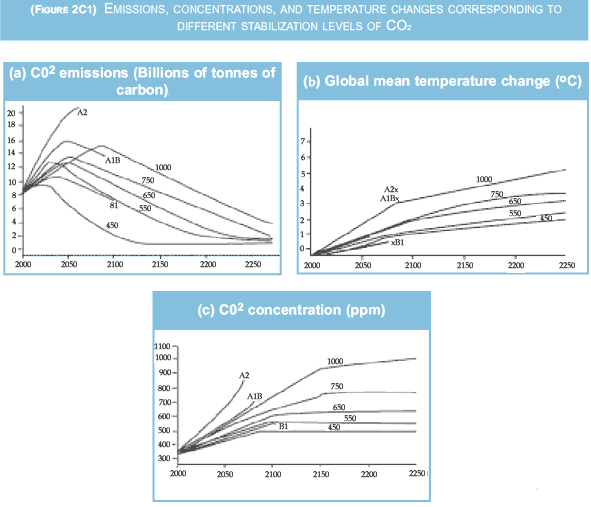 |
Because the CO2 emissions from energy conversion
processes are caused by the combustion
of fossil fuels, the use of these fuels has to be
reduced massively within the next fifty years.
Industrialised nations have contributed most of
the past increase in GHG concentrations in the
atmosphere, so the United Nations Framework
Convention on Climate Change (UNFCCC)
assumes that these countries will take special
steps (UNFCCC Article 4) to prevent dangerous
interferences with the global climate. The
German Parliament's first commission on global
climate change concluded that industrialised
countries should reduce their GHG emissions to
20% of their 1990 emission level by 2050
(Deutscher Bundestag 1991, p. 867). See
Figure 2C2. 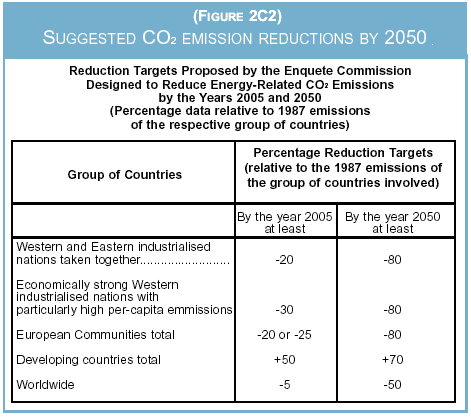 This 80% cut means that the use of
fossil fuels has to be reduced accordingly.
This 80% cut means that the use of
fossil fuels has to be reduced accordingly.
Since the reactor accident at Chernobyl there has been serious doubt whether nuclear power can safely replace fossil fuels for energy generation to the extent required to achieve this level of reduction of GHG emissions. In countries like Germany, Austria, Sweden or Denmark there is massive resistance in the population to even the modest use of nuclear power. Moreover, as the uranium resources available seem to be as limited as our reserves of oil and natural gas, and since the problem of very long term storage of spent nuclear fuel has not yet been solved, it seems to be rather unlikely that a future energy system will primarily be based on nuclear energy.
If we accept these two assumptions, a future sustainable energy system has to be based on renewable energy sources. Considering that the Earth will provide us with suitable living conditions in the solar system for something like 800 million years, that the internal resources of the planet are definitely limited by its physical size, and that the only resource income from outside the planet is solar radiation, it is quite obvious that this outside energy income will be the only long term energy source for a sustainable energy supply. Knowing the solar energy income is about 3.5*106 EJ/a and the anthropogenic world energy consumption of 1999 was about 406 EJ/a (see BMWi 2002, p. 39) it is quite obvious that the amount of direct and indirect solar energy available will be sufficient to cover the energy needs of mankind for all the time this planet will be habitable. The remaining lifetime of the sun is estimated to be about 5 billion years. Thus, there will certainly be sufficient solar energy available for the entire time that human beings may live on this planet.
Renewable energy sources are used to only a limited extent at present. They provided only 3.2% of the world consumption of commercial fuels in 1998 (Fischer 2002, table on world energy consumption). This limited use is due to the relatively high internal costs of the use of renewable energy sources. As energy markets do not take into account the external cost of the environmental and health damage caused by the use of fossil fuels or nuclear energy, investors choose to develop conventional rather than renewable energy sources (see e.g. Hohmeyer 1988, p. 108f). Thus, a transition to a renewable energy based sustainable energy system will need a policy framework that internalises the long term external costs of all energy sources including long term impacts on global climate change.
As renewable energy sources will be relatively expensive compared with present conventional ones, future energy systems can be expected to use energy far more efficiently. What would such an energy system look like and could the transition to it be possible within the time frame set by the necessity to avert a catastrophic global climate change?
2. SUSTAINABLE ENERGY SCENARIOS FOR THE EU
In 1993, a European research consortium, the LTI-Research Group, reported on what might be involved if the fifteen countries that were then members of the EU, the EU15, attempted to develop a sustainable, renewables-based energy system by 2050. Would it be possible to phase out nuclear energy while at the same time reducing CO2 emissions by 80%? (LTIResearch Group, 1998, p.1). Most of the rest of this paper is based on the results of the LTI project.
2.1 ASSUMPTIONS OF THE LTI PROJECT
As the LTI project had a broad perspective on sustainable development, some basic assumptions were made beyond the energy system. The most important of these were:
- General assumptions
- the population of EU 15 will grow from 140 million in 1998 to 164 million people in 2050
- by 2050 the standard of living in EU 15 will all be at the current Northern Europe level industrial, commercial and living areas will be developed to minimise transportation demand
- 10% of all land area will be set aside for nature preservation
- consumption patterns will change to reduce meat imports and to allow for food production with only 20% of the present input of fertilisers
- Assumptions concerning energy demand
- material use by industry will be reduced by a factor of 4 thanks to careful product design.
- recycling rates will be doubled. energy consumption in industry will be reduced accordingly.
- floor space will increase to 42 m2 per capita household size will decrease to 2.24 persons per household.
- heating demand for buildings in Northern and Central Europe will be reduced from 150 kWh/m2*a to 30-40 kWh/m2*a.
- energy efficiency of household appliances will be increased by 60-85% .
- the tertiary (service) sector will grow by 50% by 2050.
- the transport of goods will decrease by 60% since industry will be using less materials. short and medium distance flights will be abandoned in favour of rail transport.
- 50% of all journeys will be by public transport. people will travel shorter distances due to changed spatial patterns.
- passenger cars will use only two litres of fuel per 100km and trucks will use only 2/3 of their present diesel consumption.
- the overall energy demand per capita will be reduced from 4500 W/cap in 1990 to 1700 W/cap in 2050.
- Assumptions concerning energy supply
- the renewable energy sources considered in the scenario were biomass, solar radiation, wind energy, and hydropower. The share of each was based on expert judgement.
- 500 W/cap will be produced by biomass.
- PV modules will be installed on 30% of the suitable roof area supplying 150 W/cap.
- solar thermal collectors will be installed on 50% of the suitable roof area supplying 330 W/cap.
- wind energy will contribute 50 W/cap from on-shore and 160 W/cap from off-shore installations.
- solar power plants will contribute 180 W/cap. no large hydropower plants will be added.
- the use of small hydropower sites will be increased from 20-25% today to 90% in 2050 with a total contribution of hydropower of 140 W/cap.
- heat pumps will utilise environmental heat to supply 90 W/cap.
- no more than 80W/head, 5% of the total energy demand, will be supplied by fossil fuels
- no energy will be imported by the EU15.
Some of these assumptions like the ban on the import of energy or the changes in diet are rather restrictive. Most restrictions on lifestyle could be relaxed, however, if substantial imports of secondary energy produced by renewable energy sources outside the area of EU15 were allowed. Most of this would be electricity and hydrogen produced in Northern Africa, where a vast solar radiation resource is available.
2.2 TIME REQUIRED FOR A TRANSITION TO A SUSTAINABLE ENERGY SYSTEM
The 50-year timeframe adopted by LTI was chosen on the basis that the transition to a sustainable energy system needs to be achieved by 2050 in order to decrease GHG emissions sufficiently to stabilise the concentration of CO2 at about 450 ppmv. Did the study show that this was long enough to allow for all the necessary changes and adjustments to be made?
The productive capital stock of an economy is turned over at intervals anywhere between four (computing equipment) and 40 years (coal or nuclear power plants). Only the stock of private and public buildings, pipelines and large hydropower dams usually has an average turnover time of considerably more than 50 years. Thus, almost all the capital stock existing today will either be renewed or fundamentally renovated by 2050. This allows almost all energy relevant equipment to be rebuilt or, in the case of buildings, fundamentally renovated at least once before 2050. No capital stock has to be retired prematurely. Consequently, with no stranded investment to be written off, investment costs can be minimised.
Substantial changes in energy investment policy need be made early on, however. Investments in new power plants need to be considered in the light of their contribution to GHG emissions over their entire expected lifetime. This is especially important in the case of large coal power plants that can be expected to operate for 40 or more years after completion. No large coalfired power plant should be built in the EU again. A single 700 MW power plant would emit about 3 million tonnes of CO2 per year, a large part of the total amount of the emissions permitted for the whole of Germany in 2050, 200 million tonnes per year. The operation of such a plant would close off many other CO2 emitting activities.
Another policy area where rapid change is required is that new buildings and factories should be sited to reduce unnecessary transport as otherwise it will take decades to bring about considerable energy savings in transportation. Because energy and transport are currently cheap, environmental damage is not costed and there are big differences in wages between various parts of the world, we are putting in place systems that are extremely transport intensive. The internalisation of all the external costs of transport would be a big step forward as it would bring about a long-term change in the location of production relative to the markets where the products were to be sold.
With short-lived energy-relevant equipment like cars we can improve the situation gradually. Although, by 2050 average consumption of passenger cars should be 2 litres of fuel/100km, we do not need to jump to the 2 litre car by next year as the stock of cars will be turned over a number of times before 2050.
Although most technologies for renewable
energy production and the more efficient use of
energy are available today, many of them have
not enjoyed the cost reductions that will come
about when they mature and move into mass
production. As we have seen in the case of wind
energy during the last twenty years, the costs of
energy technologies can be reduced along technical
learning curves (see Figure 2C3 below
and e.g. Dieckmann 2002). Broadly speaking,
the cost reductions until the late 1980s can be
attributed to improvements in wind energy
technology while most of the cost reductions
since are due to series production and learning
about the production process. The rounded
curve is a fitted trend line with the estimated
function given in the graph.
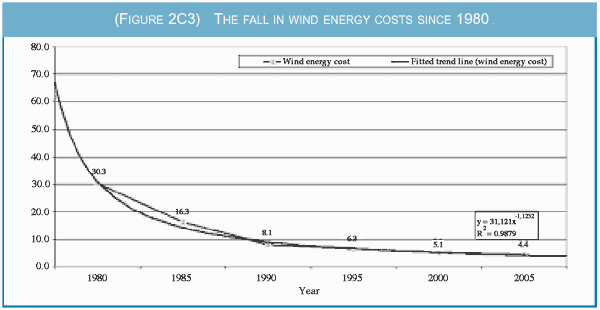
The Danish and German success with wind energy shows that fair competitive pricing as a result of the internalisation of external costs is necessary for the market diffusion of a renewable energy technology. Indeed, fair pricing seems to be as important as the development of the technology itself as it permits all further technology development and cost reductions to be achieved by private agents in the energy markets.
As a result of the increased price paid for wind
energy in Germany since 1991 - the increase
was based on a first estimate of the difference in
external costs between wind and fossil sources
- the installed capacity of wind turbines rose
from less than 68 MW in 1990 to more than
10,000 MW in 2002. (10,639 MW by
September 30th 2002). This was despite the fact
that Germany has a rather unfavourable onshore
wind energy resource. In addition, applications
to install turbines with a capacity of
about 59,000 Mw in offshore wind parks have
been filed with the federal administration as a
result of the increased rate paid for offshore
wind electricity since April 2000.
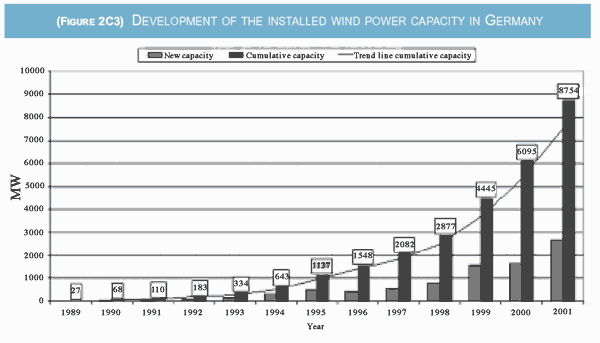 |
Although this rate of capacity growth is rather impressive, there is a danger that instruments for increased market diffusion like paying higher prices for electricity fed into the public grid can be used too early. Pushing the diffusion of an immature technology can cause substantial losses to society. If a technology is in an early phase of technical development and a number of competing basic designs are available, one of these designs might be cheaper than the others when the massive diffusion policy is introduced.
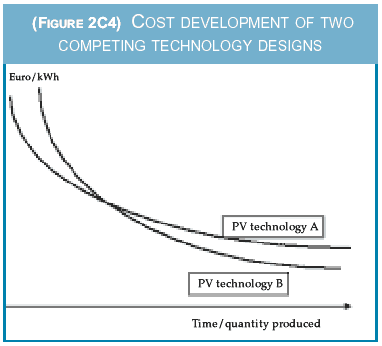 |
| If support for photovoltaics is given too soon the interior technology, A, might become entrenched in the market. |
2.3 THE PATHWAYS CHOSEN IN THE LTI PROJECT
The LTI project assumed that, on average, each
person in the EU15 would reduce their total primary
energy consumption to 1700 W/cap in
2050. This compares with a consumption of
4500 W/cap in 1990. Renewable energy sources
would supply 95% of this reduced amount of
power as nuclear energy would be phased out by
2010, coal was not to be used after 2045, and oil
and gas would only be used in rather small quantities.
Looking at the different sectors of the economy
in Figure 2C5 we find that industry's demand
falls from 1060 W/cap in 1990 to 400 W/cap in
2050, household energy demand (without transportation)
is reduced from 844 to 296 W/cap,
and the energy demand for transport goes down
from 1033 to 144 W/cap. The reductions in
transport are due to both increased efficiency
and rather drastic reductions in the distances
travelled. This last assumption may well be contested.
The energy demand from the commercial
sector (services) goes up, however, from 329 to
389 W/cap. This is due to a radical restructuring
of the economy with more services being necessary
because of lower levels of material use.
 |
If this overall reduction in energy consumption
can be achieved, less than half the primary energy
needed in 1990 will be necessary to run the
EU15 in 2050. Figure 2C6 shows how this fall
can be used to phase out fossil fuels and nuclear
energy apart from a small amount of mineral oil
(80 W/cap), which will be used in transportation.
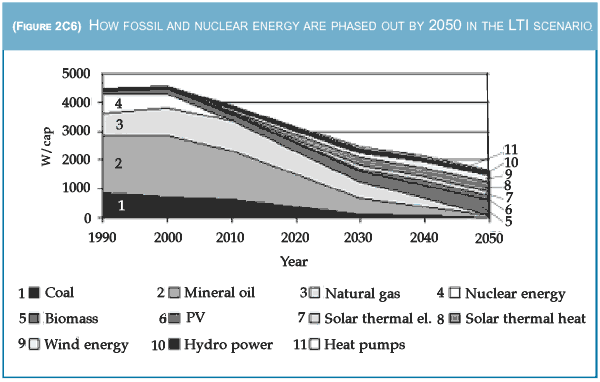 |
As conventional fuels are phased out over the 50
years, renewable energy sources will start to play
an increasingly important role. While these energy
sources supplied only about 3% of all primary
energy in 2000 their share increases to 95% of all
energy used in 2050. Figure 2C7 shows the phasing
in of the different renewable energy sources
in EU15 under the sustainable energy scenario.
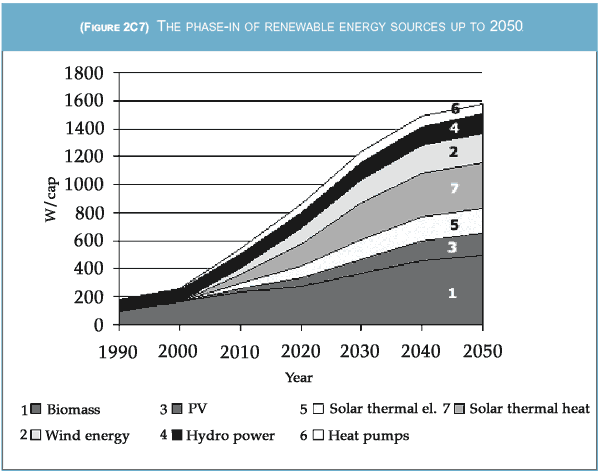 |
| |
In 2050 the largest share of all renewables will come from biomass (500 W/cap), which has a central role to play in the future energy system, as it can be used to produce liquid fuels for transportation and it can be stored without energyconsuming conversion processes. Second in volume will be solar thermal heat contributing 330 W/cap. While the use of biomass and hydropower already supply substantial amounts of energy today, it is assumed that solar thermal heat like most of the other renewable sources start to contribute sizeable amounts only after 2000. Third in volume will be wind energy contributing about 210 W/cap with most of the resource being located in coastal areas and more than two thirds being generated from offshore wind farms. Solar thermal power plants located in Southern Europe will contribute about 180 W/cap to the electricity generation of EU15. For both wind and solar thermal power plants, the installations will mainly be large central installations feeding into an integrated European electricity grid. By contrast, photovoltaic electricity production (PV) will be done by decentralised installations on roofs contributing about 150 W/cap. Comparing the available resources and the present system costs for wind and PV would lead me to somewhat different assumptions concerning the scenario with substantially larger share of wind energy (which is comparatively inexpensive and only used to 17% offshore) and a rather small share of PV (which is by far the most expensive source of energy used) in the overall system. As Figure 2C7 shows, all renewable energy technologies expand at a similar pace between 2000 and 2050, most rapidly between 2020 and 2040 and rather more slowly after that.
The project checked not only whether the total amount of energy would be adequate to meet the system's needs but also whether there would be enough at different times of year and different times of day.
By 2050 only 82 W/cap of oil will be used in the system, solely in transportation. Even if one does not agree with all assumptions LTI made, the reduction pathways for specific energy use and the expansion pathways for the use of renewable energy sources calculated for the group's scenario show that a transition to a sustainable energy system is possible for EU15 within the next 50 years, the time span available for such a transition with respect to global climate change.
2.4 ENVIRONMENTAL EFFECTS, COSTS AND EMPLOYMENT IMPACTS OF THE TRANSITION
As shown is Figure 2C8, the CO2 emissions due
to the use of energy in EU15 can be reduced by
90% in 2050 as compared to the starting point in
1990. Thus, more than the necessary reductions
in greenhouse gases (80%) is possible
within the given time frame.
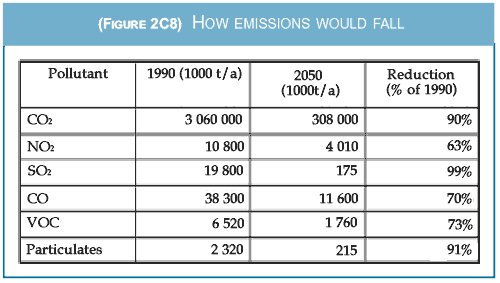 |
| |
What is more, other important pollutants will be reduced simultaneously by 63% at the minimum (NOx) and 99% at the maximum (SO2). Thus, the resulting energy system is not just climate friendly but it will reduce pollution in many important aspects quite drastically.
Nevertheless, it will be necessary to find additional ways of reducing emissions of volatile organic compounds (VOC) and of nitrogen oxides, NOx.
We may conclude that it is possible to change the energy system of EU15 into a sustainable energy system by the middle of this century and thus achieve the necessary reductions in greenhouse gases (GHGs) to stabilize their concentrations at comparatively low levels - provided that other countries change their energy systems too.
The costs of the sustainable energy system are not prohibitively high. Figure 2C9, shows that the 'total annual cost' of a conventional system would be €182 billion compared with €254 billion for the sustainable system. If the external costs of the conventional system apart from the global warming are taken into account, its cost rises to €218 billion a year. And if the cost of global warming is added too, the total is €754 billion a year. Thus, we can conclude that the sustainable energy scenario achieves its goal, namely the reduction to GHGs below critical levels, at comparatively low cost. Finally, the direct and indirect employment effects of the sustainable energy scenario have been analysed and compared with those of conventional energy sources. This analysis resulted in gross annual employment effects of the sustainable scenario of 3.8 million personyears in 2050 which compare to 3.2 to 3.4 million person years of employment that would be created by conventional energy sources. Thus, the net impact of the sustainable scenario on employment would be positive in the range of 340,000 to 580,000 person-years in 2050. Although such employment effects should not be the prime reason for making the transition to renewable energy systems, knowing that the net effect on employment will be positive makes for an easier decision.
3 CONCLUSIONS
Looking at the issue of the time required for a European transition to renewables from the perspective of the necessary transition to avoid substantial human interference with the global climate system, which at the moment seems to be the most urgent reason for such a change, we can conclude on the basis of some first evidence that such a transition is:
- possible within 50 years
- can reduce CO2 emissions more drastically than required by climate policy
- will reduce other pollution substantially
- will only be modestly more expensive than conventional energy supply strategies (in terms of internal costs)
- will be substantially less expensive for society if the full external costs are taken into account and
- will have positive net employment effects within the European Union.
Nevertheless, this paper does not address the question of the minimum time required for such a transition from the present system to a sustainable energy system based almost exclusively on renewable energy sources. Looking at the operational lifetime of a large conventional power plant of about 40 years, it is plausible that it will take in the order of at least 30 to 40 years to achieve such transition without creating problems of stranded investment and the resulting substantial costs to society. If necessary for other reasons, however, a transition can probably be achieved in a substantially shorter time span, if stranded investment and high costs to the economy are accepted. At the moment this does not seem to be necessary.
Drawing the conclusion that the transition is
possible within the given time frame underscores
at the same time the fact that such a low
cost transition will only be possible if we take
the necessary steps as soon as possible. We need
to decide within the next few years not to invest
into long-lasting high CO2 emission technologies
any more. Which is to say that no coal fired
or nuclear power plants should ever be built in
Europe again.
 |
LITERATURE
Bundesministerium für Wirtschaft und Technologie (no year): Energiedaten 2002 - Nationale und internationale Entwicklungen, Berlin
Deutscher Bundestag (ed.) (1991): Protecting the Earth - A Status Report with Recommendations for a New Energy Policy. Third Report of the Enquete Commission of the 11th German Bundestag 'Preventive Measures to Protect the Earth's Atmosphere'. Volume 2. No publisher, Bonn
LTI-Research Group (ed.) (1998): Long-Term Integration of Renewable Energy Sources into the European Energy System. Physica-Verlag, Heidelberg
Loske, Reinhard (1996): Klimapolitik im Spannungsfeld von Kurzzeitinteressen und Langzeiterfordernissen. Metropolis Verlag, Marburg
IPCC [Intergovernmental Panel on Climate Change] (2001): Climate Change 2001: Synthesis Report. A Contribution of Working Groups I, II, and III to the Third Assessment Report of the Intergovernmental Panel on Climate Change. [Watson, R. T. and the Core Writing Team (eds.)]. Cambridge University Press, Cambridge, U.K.
Albrecht, Birgit et al. (eds) (2001): Der digitalte Fischer Weltalmanach 2002. Fischer Taschenbuch Verlag, Frankfurt a. M.
Hohmeyer, Olav (1988): Social Costs of Energy Consumption: External Effects of Electricity Generation in the Federal Republic of Germany. Springer-Verlag, Berlin
Vahrenholt, Fritz (2001): Globale Tendenzen der zukünftigen Energieversorgung. Manuscript published on the internet as PDF document retrieved on October 18th 2002 from www.ipp.mpg.de/de/presse/pi/13_01_vahrenholt.pdf
BWE (2002): Zahlen zur Windenergie. Table retrieved on October 27th 2002 from www.wind-energie.de/informationen/informationen.htm
Diekmann, Jochen (2002): Förderung der Windenergie erfolgreich. DIW-Wochenbericht 9/02. Retrieved as html-file on October 26th 2002 from www.diw.de/deutsch/publikationen/wochenberichte/docs/02-09-2.html
United Nations (1992): United Nations Framework Convention on Climate Change. Retrieved as PDF-file on October 20th
2002 from http://unfccc.int/resource/docs/convpk/conveng.pdf
This is one of almost 50
chapters and articles in the 336-page large format book, Before the Wells
Run Dry. Copies of the book are available for £9.95 from Green Books. Continue to Section D of Part Two: Building a Lean Economy for a fuel-poor future
